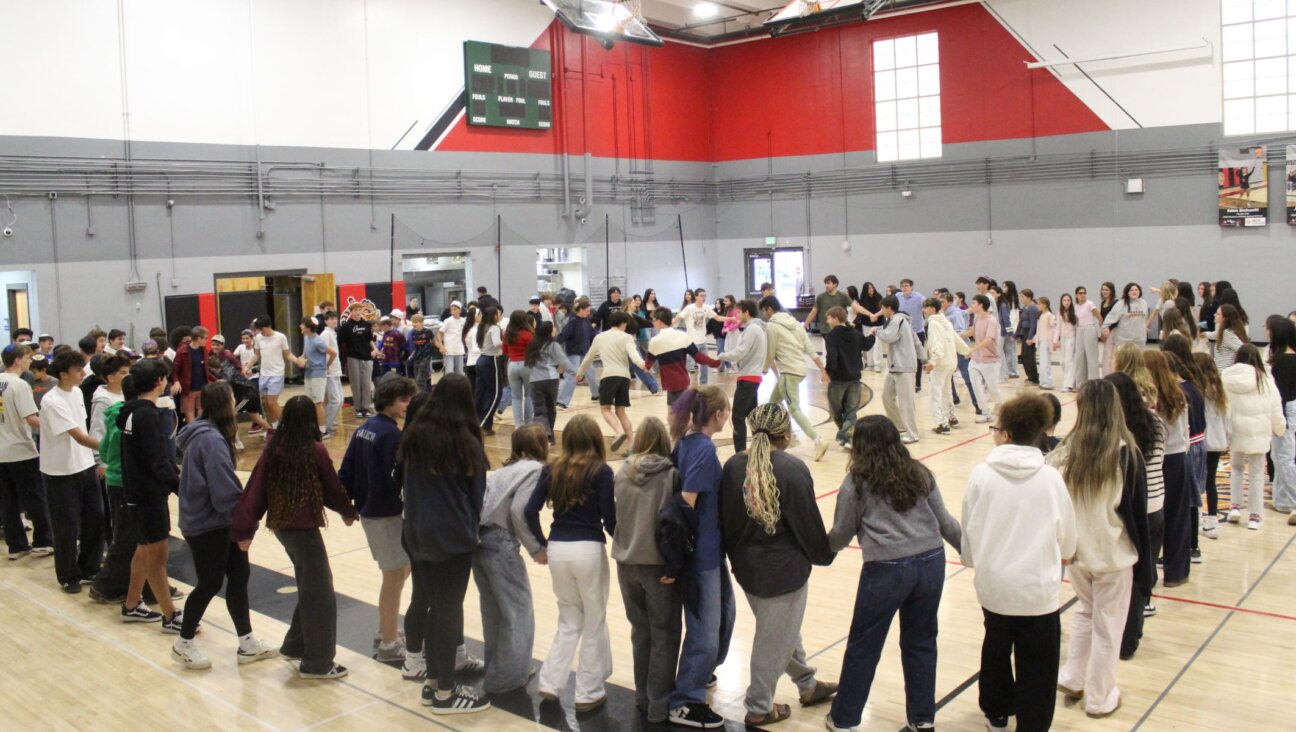Sexuality on Sesame Street

Image by Lisa Anchin

Image by Lisa Anchin
Elmo’s radio broke. He shook his furry head and banged on his toy. Elmo wanted to listen to music. He wanted to sing the ABCs, or a song about shapes and circles or fish in the sea.
I was 25 years old when I first watched “Sesame Street.” Oh, I knew Bert and Ernie from children’s books — the Yellow Rubber Ducky and Oscar the Grouch. But in the ultra-Orthodox Brooklyn neighborhood of Boro Park, TV is forbidden. There is “Uncle Moishy” and “The Marvelous Middos Machine” — but “Sesame Street,” Barney the Purple Dinosaur and other goyishe nonsense are seen as unnecessary and contaminated.
I was a young mother of two toddlers when I defied this rule. I had picked up a “Sesame Street” DVD while browsing through the sale items at the local Target. Big Bird stared out from the cover, tempting me. Elmo stood right behind him, a wide grin on his face. They seemed so harmless, all smile and fluff.
I thought of the pile of “Uncle Moishy” videos that my children had watched too many times to count, and my past teachers’ warnings flashed through my mind: “It begins with children’s movies, and ends in porn.” Then, in a moment of determination and defiance, I decided I’d buy it.
When I came home, I waved the DVD in front of my cousin’s eyes.
“According to statistics,” I explained, “children who watch ‘Sesame Street’ know the ABCs and numbers 1 through 10 better than those who don’t. It’s a proven fact. I’m telling you!”
My cousin, holier than I, peered at the picture of the oversized yellow bird. She observed Elmo. They looked unfamiliar, colorful, gentile. But I did not care.
“It’s ‘Sesame Street’!” I said. “It’s educational, it’s healthy, and it stimulates the brain cells!”
I sat my children in front of the computer in the den. I slipped in the DVD. I then leaned back in the chair, sighing contentedly. There are wonderful things out there for my children to enjoy. Why watch the same old things?
We met Bert and Ernie first. Then Cookie Monster strolled in, declaring that C is for cookies. My three-year-old son giggled, my daughter waved her toes in the air. Elmo entered, giggling and hugging anyone he could get his hands on. But then his toy radio broke, and he could not fix it. He banged his furry paws on it but nothing happened. His head drooped sadly. He stared at the toy. Right then, from behind him, a tall, dark lady slithered in.
“Hi Elmo,” she said. “What’s wrong?” I stared at her in shock.
The woman was dressed in a halter top and a mini skirt. She smiled brightly, seemingly oblivious to the mortifying fact that her halter top did not fully cover her midriff. And then she began singing the ABC song. She waved her hands in the air as the camera zoomed in on her. Her midriff loomed onscreen.
“Elmo,” she said, “Won’t you sing with me?”
Elmo sang along. I stared at the lady’s cleavage and then worriedly at my children. They did not seem to notice. Still, who knew what insidious influences were now creeping into their pure minds?
And then it happened. The lady with the bare midriff, with the mini skirt and uncovered thighs swayed her entire body. She shook her hips to the right, to the left, side to side, carelessly, suggestively, and all without a shred of embarrassment.
I stared at the screen in disbelief. I heard my cousin, the one who is holier than I, come down the stairs, and I jumped. I ran to the computer.
I frantically pressed at random keys. My daughter whined angrily, “Mommy! Moooove!” I fumbled, bending protectively over the screen and pressed the forward button, hard. My toddler wailed. She wanted the hip-shaking lady, only the hip-shaking lady, now.
“More, more, more,” she screamed. “Like dat.” She stood on the chair, shaking her hips right to left, side to side, to show me.
I laughed nervously. I quickly explained: “The DVD broke in the middle, the whole screen started jumping, I’m forwarding it —”
“Jumping? You just bought it today.”
“I know, I mean I don’t know. Of course I know — it just started jumping.”
My cousin stepped forward. “Let me check it. I’ll fix it.”
My eyes opened very wide.
“Oh no,” I said. “The kids are screaming. We’ll just watch from here. This, here — See, it’s perfect. Elmo’s counting fish.” And then, a miracle: The phone rang. It was her husband.
I breathed.
I glared with suspicion at the screen. I had always known that the secular world is filled with sex and drugs and nothing else — but on “Sesame Street,” too?
You see, in the ultra-Orthodox world where I grew up, we are careful with our womanliness, our sexuality. We do not suppress our womanliness; we only hide it away so it can never be seen. This keeps us safe. This ensures that our womanliness cannot be exploited the way it is in the outside world. This is why we dress modestly. This is why we don’t watch TV. This is why we are not taught anything pertaining to our sexuality until very shortly before our wedding day. And this is why, when we dance, we don’t move our hips. Or neck. Or waist. Or anything that might slip a hint that when God created us, he made us female. We do, however, trot. We cha-cha to the right and cha-cha to the left, carefully keeping our bodies in straight lines, so as not to expose any hips we might unknowingly have.
It says in the Torah: One sin leads to another. A women who shakes her hips (hence, her tush) is declaring her womanliness in public, like a whore, with an obvious desire for sex. A passerby sees her shaking hips and is provoked to sinful desire. Which leads to evil thoughts, unrestrained sex and then drugs. More unrestrained sex and drugs. Then, hell.
The matter was deeply disturbing to me. Millions of innocent children were exposed to some lady’s womanliness, hence tush, hence sex, hence drugs, and hell, and all on “Sesame Street.” Now what was I supposed to tell my children?
Over time, I calmed down. In the months and years that followed, I watched more episodes of “Sesame Street,” movies, TV and popular entertainment. I found myself in an alien world where womanliness is not a secret, but a mystery. A place where a woman’s body is considered a beautiful thing.
It was strange, watching women flaunt their womanliness while demanding respect for it at the same time. In this place, womanliness is protected not by females hiding themselves, but by men restraining themselves. I could not understand it. An entire society that refuses a morality based on what women wear. It was a foreign concept.
On a spring afternoon, a year after the Elmo fiasco, I met my friends in a local park. Our children chased each other around the playground as we sat on the bench, chatting about our toddlers and pregnancies. My high school classmate, Chany, told us of her latest ordeal.
“Could you believe it? My oldest started developing…. She is only 11. It seems like she was just born, and there I was a few days ago explaining to her all about periods and everything else. Of course, she was horrified. She told me, ‘Mommy, ugh! That is so yucky! Why do these things happen?’” We laughed sympathetically.
Chany continued: “I told her that this is the way Hashem made the world. There are things that are just yucky, but there’s nothing to do. Every woman in the world goes through this… eventually, you get used to it!”
My friends nodded. We had all been through this, learning the embarrassing facts of our bodies from our mothers, who learned them from theirs. Eventually, the shock wore off, and life went on.
I chatted with my friends as we left the park. But a chasm had opened between us. I called my daughter, playing on a swing, her lithe, sweet body arching up at the wind, and I knew at that moment we have it all wrong. We do not look at our bodies with respect or dignity; we see them as things of shame, our maturation a dreaded process. When our daughters look at their breasts, they see them as ugly things, pieces of machinery necessary for feeding babies. Things that boys are lucky not to have.
So how do I find my own way? How do I create a healthy space between fearful paranoia and obsessive desire? A place where my children can appreciate their sexuality without being consumed by it? How do I raise a child who won’t go into cardiac arrest over a dancing woman on “Sesame Street”?
It’s been a long journey. Slowly, I learn. My own child taught me as she grew. When she was five years old, she sat in the bubble bath, playing with a naked doll, staring at it curiously.
“What does Hashem call this?” she asked me pointing to elbow.
“Elbows,” I said.
“What does Hashem call this?” She pointed to her knees.
“Knees.”
“And what does Hashem call this?” she asked, pointing to that which does not have a word.
I mumbled something incomprehensible, but my daughter wanted to know.
“This place. What does Hashem call this?” She pointed to the part between the doll’s legs. “What’s the name of it?”
I cringed as I said it, forcing it out, a word so shameful it seemed like it had never been said out loud before, as if an accident of creation.
“It’s called a ‘vagina,’” I said. “Vah-gina…” I watched her repeat the word simply and without fear: “Vah-gina. This is the vah-gina.” A part of the body that God made, too.
I wanted to hug her innocence. I wanted to take a piece of it and hide it safely away for the time when “vagina” would be more than just a word. I wanted to promise her that she would never be a stranger to herself, and that when the buds begin sprouting on her adolescent chest, it would be a moment of wonder. I wanted to promise her that she’d know the beauty of her body, her arcs and curves, and that her sexuality is a gift: the miracle of being a woman.
I wanted her to differentiate between modesty and a suppression that is just another kind of exploitation, one that shrouds women with the fear of men. We have learned to see our bodies through men’s insecurities, and we’ve become afraid to dance.
I wanted her to move, to swing her hips side to side, to see that sexuality is a deeply private part, but not a hidden one.
It is said that in this world even the most insignificant creatures have a divine purpose. Nothing is for naught. These are the words of the wise and the sages. I don’t know if the wise or the sages knew of Elmo, nor of “Sesame Street,” or what they’d say about such furry creatures playing any sort of a role in heaven’s divine plan.
But they played a role in my family. I never frantically pressed the forward button on “Sesame Street” again. Now, I laugh and remember, watching my children move along with the beats, giggling happily with Elmo and the dancing lady until the end of the ABCs.
Judy Brown wrote the novel “Hush” under the pseudonym Eishes Chayil. “Inside Out” is her essay series about life in the ultra-Orthodox world. It is based on true events, but her characters’ names and identities have been changed; some are composites, comprising several real-life people.















